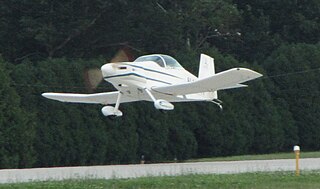Related Research Articles

Stoddard-Hamilton Aircraft, based in Arlington, Washington, was a designer and supplier of high-performance homebuilt aircraft kits, offering parts and plans to homebuilders. The company's popular Glasair aircraft series are low wing, two-seat fiberglass designs.

Homebuilt aircraft, also known as amateur-built aircraft or kit planes, are constructed by persons for whom this is not a professional activity. These aircraft may be constructed from "scratch", from plans, or from assembly kits.

The Rutan Model 54 Quickie is a lightweight single-seat taildragger aircraft of composite construction, configured with tandem wings.

The Thorp T-18 is an American, two-place, all-metal, plans-built, homebuilt aircraft designed in 1963 by John Thorp.

The Glasair I, originally built as the prototype Glasair TD taildragger, is a high-performance homebuilt aircraft built of fiberglass. Created by Tom Hamilton as a fast, two-seat kitplane, the Glasair TD was derived from the earlier Tom Hamilton Glasair and first flew in 1979. Hamilton formed Stoddard-Hamilton Aircraft that year to produce and market the kit, which was the first pre-molded composite aircraft available to builders. It was introduced to the public at the 1980 EAA Convention in Oshkosh, Wisconsin, winning Hamilton the 1985 EAA August Raspet Award for "significant advancements in the field of light aircraft design".

Glasair Aviation USA, LLC is a Chinese-owned aircraft manufacturer based in Arlington, Washington that produces the Glasair and Sportsman 2+2 line of homebuilt aircraft. More than 3000 Glasair kits have been delivered worldwide.

The Wheeler Express is a four-seat low-wing composite homebuilt aircraft.

The Plane Driven PD-1 is a modification to the Glasair Sportsman 2+2 to convert it into a practical roadable aircraft. The approach is novel in that it uses a mostly stock aircraft with a modified landing gear "pod" that carries a separate engine for road propulsion.
The Rans S-11 Pursuit is an American single-engined, tractor configuration, single-seat, low-wing aircraft, based on the lifting body principle, designed and built by Randy Schlitter. The Pursuit was listed as under development in 1998, but only prototypes were ever completed and the aircraft is not part of the present Rans aircraft line.

The Sport Flight Talon is a high-wing, pusher configuration single-engine, conventional landing gear homebuilt aircraft or ultralight aircraft, that was produced by Sport Flight Aviation of Sandy, Oregon in kit form for amateur construction.

The Titan Tornado is large family of cantilever high-wing, pusher configuration, tricycle gear-equipped kit aircraft manufactured by Titan Aircraft of Austinburg, Ohio, for amateur construction.

The Salvay-Stark Skyhopper I is a low-wing single-place homebuilt aircraft designed in 1944.

The Stoddard-Hamilton Glasair III is an American two-seat, high performance homebuilt aircraft designed and built by Stoddard-Hamilton Aircraft of Arlington, Washington as an addition to the Glasair range of aircraft for amateur construction. Glasair II and III assets were purchased by Advanced Aero Components in September, 2017.

The Halsted BH-1 Saffire is a homebuilt aircraft design introduced in the early 1990s.

The Glasair GlaStar is an American amateur-built aircraft that was designed by Tom Hamilton and produced by Stoddard-Hamilton Aircraft and later Glasair Aviation. It was first flown in 1994 and was superseded in production by the Glasair Sportsman 2+2 c. 2005. When it was available the aircraft was supplied as a kit for amateur construction.

The Stoddard-Hamilton Glasair II is an American amateur-built aircraft that was designed by Tom Hamilton and produced by Stoddard-Hamilton Aircraft and later Glasair Aviation as a kit for amateur construction. It was first flown in 1989, and remained in production in 2012.

The Christavia Mk I is a Canadian two-seats in tandem homebuilt aircraft designed by Ron Mason. The aircraft is supplied in the form of plans for amateur construction. Designed for missionary flying in Africa, the aircraft's name means "Christ-in-Aviation". The Christavia Mk II is a side-by-side configuration version.

The Stewart S-51D Mustang is an American aerobatic homebuilt aircraft that was designed by Jim Stewart and produced by Stewart 51 of Vero Beach, Florida, introduced in 1994. When it was available the aircraft was supplied as a kit for amateur construction.
The Air Command Commander Tandem is an American autogyro that was designed and produced by Air Command International of Wylie, Texas. Now out of production, when it was available the aircraft was supplied as a kit for amateur construction.

The Glasair Merlin is a light-sport aircraft under development by Chinese-owned, United States–based Glasair Aviation. It will be supplied as a ready-to-fly Special LSA aircraft.
References
- 1 2 "35 Years of Fast Glas". Sport Aviation: 52. May 2014.
- ↑ "Glasair 30th anniversary fly-in held at Flabob" . Retrieved 11 June 2014.
- ↑ Peter Garrison (November 1983). "Glasair RG". Flying Magazine: 49.
- ↑ "Aircraft Spruce Glasair" (PDF). Retrieved 11 June 2014.